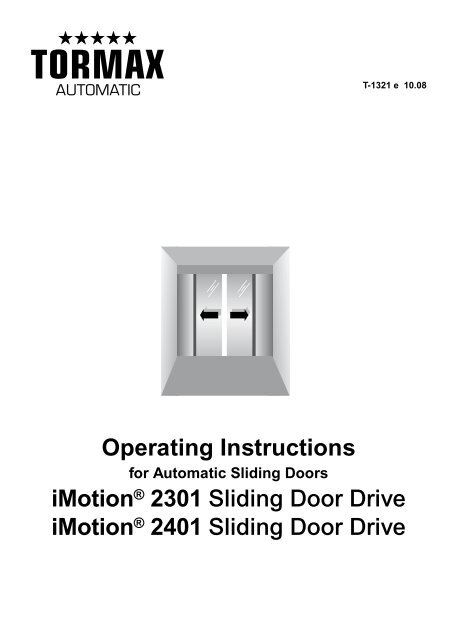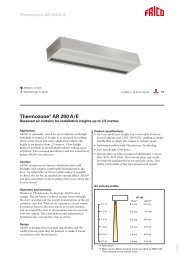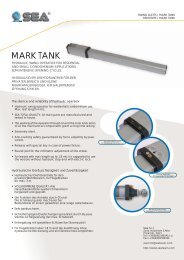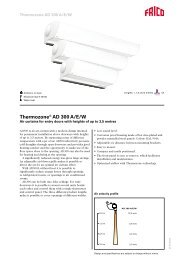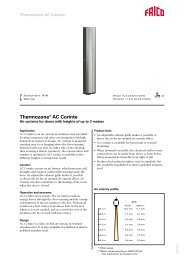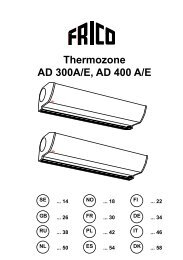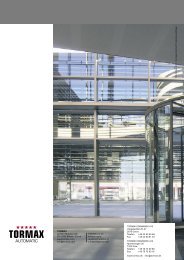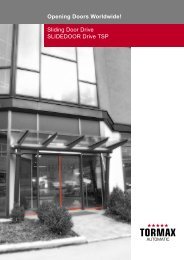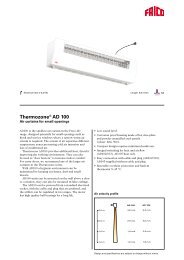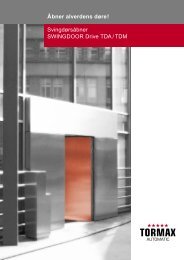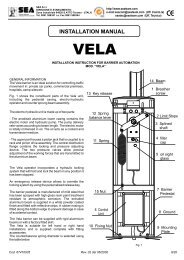Operating Instructions - tormax danmark a/s
Operating Instructions - tormax danmark a/s
Operating Instructions - tormax danmark a/s
You also want an ePaper? Increase the reach of your titles
YUMPU automatically turns print PDFs into web optimized ePapers that Google loves.
T-1321 e 10.08<br />
<strong>Operating</strong> <strong>Instructions</strong><br />
for Automatic Sliding Doors<br />
iMotion ® 2301 Sliding Door Drive<br />
iMotion ® 2401 Sliding Door Drive
Content<br />
1 Regarding these <strong>Instructions</strong> 3<br />
2 Safety 4<br />
2.1 Preconditions for the Operation of the System 4<br />
2.2 Permissible Use 4<br />
2.3 Taking the System Out of Service in Case of Fault 4<br />
3 Functions of the System 5<br />
3.1 <strong>Operating</strong> Modes 5<br />
3.2 Automatic Door Operation with Sensors 5<br />
3.3 Traffic Control 5<br />
3.4 Automatic System Monitoring 5<br />
3.5 Electromechanical Lock 5<br />
3.6 Operation on Power Failure 6<br />
4 Commissioning 6<br />
5 Operation 6<br />
5.1 Operation Through TORMAX User Interface 7<br />
5.2 Operation through 3-Position Switch 7<br />
5.3 Operation on Power Failure 8<br />
6 <strong>Operating</strong> Modes 8<br />
7 Maintenance 9<br />
7.1 Cleaning and Maintenance 9<br />
7.2 Checks by the System Operator 9<br />
7.3 Annual Maintenance and Inspection 11<br />
8 Trouble Shooting 12<br />
9 Additional Notes 14<br />
9.1 Technical Data 14<br />
9.2 Warranty Claims 14<br />
9.3 Optional Extras 14<br />
9.4 Disposal 14<br />
First edition: 10.08<br />
We print on environment-friendly paper bleached without chlorine.<br />
The companies Landert Motoren AG and Landert GmbH are certified according to ISO 9001.<br />
2 <strong>Operating</strong> instructions iMotion 2301/ 2401 T-1321 e
1 Regarding these <strong>Instructions</strong><br />
Addressee/Status<br />
The person responsible for operation and maintenance of the system is referred to as “system<br />
operator”. The system operator is responsible for the operation and maintenance of the system.<br />
Area of Application<br />
This document is applicable for sliding doors with TORMAX automatic door operator of type:<br />
iMotion® 2301 Sliding Door Drive<br />
iMotion® 2401 Sliding Door Drive<br />
Explanation of Symbols<br />
In these instructions we have marked all positions which concern your safety with this symbol.<br />
This symbol warns of electrical voltage.<br />
<<br />
<br />
Text passages in grey background must be absolutely observed for sound operation of the<br />
system! Disregard may cause material damage.<br />
<strong>Operating</strong> functions that are marked by the accompanying symbol correspond to the basic settings;<br />
however, the fitter can reprogram them.<br />
This symbol marks optional components, which are not installed in all systems.<br />
Symbols for <strong>Operating</strong> Modes<br />
<strong>Operating</strong> mode OFF<br />
<strong>Operating</strong> mode AUTOMATIC 1<br />
<strong>Operating</strong> mode AUTOMATIC 2<br />
P<br />
<strong>Operating</strong> mode EXIT<br />
<strong>Operating</strong> mode OPEN<br />
<strong>Operating</strong> mode P Manual Operation<br />
Languages<br />
These instructions are available in different languages. Please ask your TORMAX dealer.<br />
Applicable Documents<br />
In the system test book, checks are listed that must be performed on periodic examination of<br />
the system (see also section 7.3). The location of the test book is at the respective door system.<br />
System test book: T-879 e<br />
<strong>Operating</strong> instructions iMotion 2301/ 2401 T-1321 e 3
2 Safety<br />
2.1 Preconditions for the Operation of the System<br />
The door system was planned, installed and checked by qualified professionals with regard to<br />
performance and safety before it was handed over to the system operator.<br />
The system operator was instructed by the installation company concerning operation and<br />
maintenance of the system as well as the dangers associated with system operation.<br />
Prior to commissioning of the door, these operating instructions – in particular the safety notes<br />
– are to be perused and they must be observed!<br />
In addition to the operating instructions, the generally applicable legal and the safety-relevant<br />
regulations and rules of industrial medicine for accident prevention and for environmental protection<br />
in the respective country, in which the system is operated, are also applicable.<br />
The responsibility for the instruction of the service personnel, the permissible use and the adherence<br />
to the maintenance regulations lies with the system operator. Get acquainted with the<br />
operation of the system by studying the operating instructions.<br />
Use the system only in a technically sound condition. Safety devices may not be removed or<br />
made ineffective. Make sure that possible fault situations are eliminated immediately by qualified<br />
professionals.<br />
For a most secure and reliable operation of the system, the door automation system must be<br />
serviced at least annually and submitted to a safety-relevant examination by a qualified professional<br />
trained for this kind of work. If this work is not carried out by the designated person, the<br />
manufacturer will reject any product liability and warranty.<br />
2.2 Permissible Use<br />
The door automation system TORMAX iMotion 2301 and iMotion 2401 Sliding Door Drive is<br />
built according to the current state of technology as well as the recognized safety-relevant<br />
rules.<br />
The sliding door system is intended exclusively for the deployment in dry rooms and/or, for<br />
outer doors, at the inside of a building in the pedestrian passageway. The operator can only be<br />
used at the exterior of a building if additional protective measures are taken and under observance<br />
of the acceptable environmental conditions.<br />
Any other use, or any use exceeding this aim, is deemed as not used in accordance with its<br />
intended purpose. The manufacturer will not be liable for damages resulting from such applications.<br />
The risk will be borne entirely by the operator of the door system, i.e. the system operator.<br />
Arbitrary changes to the system will exempt the manufacturer from any liability for damage resulting<br />
from this.<br />
2.3 Taking the System Out of Service in Case of Fault<br />
The door automation system must be taken out of service as soon as faults or deficiencies<br />
occur that may impair the safety of people.<br />
• Switch off the mains supply to the system<br />
• Select operating mode “P” if system operation will be continued by means of the internal<br />
battery backup system.<br />
• Open the door manually if it is installed in an escape route.<br />
For information relating to fault indication and trouble shooting see chapter 8.<br />
4 <strong>Operating</strong> instructions iMotion 2301/ 2401 T-1321 e
3 Functions of the System<br />
3.1 <strong>Operating</strong> Modes<br />
The door automation system can be operated through the TORMAX user interface u with 6<br />
operating modes and status display or optionally through a simple rocker switch u with 3 operating<br />
modes.<br />
3.2 Automatic Door Operation with Sensors<br />
In automatic operation (operating mode AUTOMATIC 1), the door opens automatically to both<br />
sides through sensors when a person approaches. In exceptional cases, it opens through deliberately<br />
to be activated switching devices such as push buttons or card readers for controlled<br />
access.<br />
A key switch usually permits access to the door from the outside also in operating mode EXIT<br />
or OFF. The door unlocks, opens and closes again as soon as no further sensors are activated<br />
any more after expiry of a separately adjusted hold-open time.<br />
The sensors for the door opening and the maintained opening of the door are arranged and<br />
adjusted in such a way that the door opens promptly and remains open as long as a person is<br />
within the operating range of the door leaf. The door can close nevertheless but only after an<br />
attendance time of approx. > 1 minute.<br />
The reduced closing speed, which is adjusted by the fitter and adapted to the door weight, in<br />
combination with a force of < 150 N, prevents an excessive impact on a person by the moving<br />
leaf. Additionally, the obstacle is detected by the control system and an automatic reversal of<br />
the door is initiated.<br />
Sensors for safeguarding the moving leaves can also be present in opening direction depending<br />
upon the surrounding conditions (e.g. column near the operating range) and design of the<br />
system (safety clearances). When a person moves into the danger area, the door leaf stops or<br />
slows down to a very low speed depending upon the adjustments performed by the fitter.<br />
3.3 Traffic Control<br />
The passageway can optionally be blocked in one direction (operating mode EXIT) or be completely<br />
closed (operating mode OFF). In these operating modes, an optional electromechanical<br />
lock can be used for protection from unauthorized access.<br />
For protection from environmental influences (wind / cold weather / heat), the door can be operated<br />
with a smaller opening width (operating mode AUTO-MATIC 2).<br />
3.4 Automatic System Monitoring<br />
The control system monitors the safety sensors by cyclic active testing. Further, the control<br />
system performs continuously internal system tests. On failure of a safety-relevant component,<br />
the system changes automatically into a safe state. Thereby, the fault number is displayed on<br />
the user interface.<br />
Please refer to chapter 8 “Trouble Shooting” for further information.<br />
3.5 Electromechanical Lock<br />
The system can be locked in the closed position through an optional electromechanical lock in<br />
operating mode OFF and optionally also in other operating modes (e.g. EXIT).<br />
<strong>Operating</strong> instructions iMotion 2301/ 2401 T-1321 e 5
The locking facility is monitored. A possible fault in the lock operation can thus be displayed<br />
immediately on the user interface. Details see chapter 8 “Trouble Shooting”.<br />
On power failure the locking facility can be activated directly through the optional manual control.<br />
3.6 Operation on Power Failure<br />
The following functions are possible according to specifications.<br />
• Immediate emergency opening activated through a mechanical energy storage.<br />
• Immediate emergency closing through a mechanical energy storage.<br />
• Immediate unlocking (if programmed by the fitter).<br />
• Continued operation of the system through a battery unit during a determined time with door<br />
opening before the battery shuts down. In operating mode OFF the door remains locked.<br />
• Unlocking and opening of the from the outside through the key switch and through the battery<br />
unit.<br />
4 Commissioning<br />
Before switching on mains supply:<br />
• Unlock the optional mechanical locking mechanisms e.g. floor lock.<br />
• Make sure that the operating range of the door leaves is free of items such as umbrella stands<br />
or trolleys.<br />
• Check if the floor guide (particularly a continuous guide) is clean and free from items (e.g.<br />
pebbles or snow).<br />
• Switch on mains voltage and select the operating mode, e.g. AUTOMATIC 1.<br />
The first motion after switching on mains supply for the first time takes place slowly with indication<br />
of H61 and H62. Thereby, the control system checks the travelling path of the door leaf<br />
and determines the end position.<br />
The door is now ready for use.<br />
5 Operation<br />
The following operating devices are available for the operation of the system depending upon<br />
outfit.<br />
- TORMAX user interface u<br />
- Lock for user interface u<br />
- TORMAX 3-position switch u<br />
- Key switch u or card readers outside u<br />
- Manual control for door lock u<br />
6 <strong>Operating</strong> instructions iMotion 2301/ 2401 T-1321 e
Systems without user interface or 3-position switch are either provided with a fixed operating mode,<br />
e.g. AUTOMATIC 1, or are centrally controlled by a time clock (e.g. OFF / AUTOMATIC 1).<br />
Push buttons, elbow switches etc. can be installed in place of, or in addition to the sensors.<br />
5.1 Operation Through TORMAX User Interface<br />
Selection of the <strong>Operating</strong> Modes<br />
Symbols for<br />
operating mode<br />
OFF<br />
AUTOMATIC 1<br />
AUTOMATIC 2<br />
EXIT<br />
OPEN<br />
T1321_1e<br />
Selection<br />
key 1<br />
upwards<br />
Electr. door lock<br />
Additional operating<br />
mode P<br />
Selection<br />
key 2<br />
downwards<br />
• Unlock optional lock for user interface.<br />
• Press selection key 1 or 2 briefly. The corresponding operating mode is displayed.<br />
Indication of Faults<br />
E.g. H31 or E11 For the significance of the indication see chapter 8.<br />
• Reset the indication by briefly pressing selection key 2<br />
System Reset<br />
• Press selection key 2 for at least 5 seconds.<br />
The software is restarted. Subsequently, the control system performs a calibration run, checks<br />
the travelling path and searches again for the end positions. The display shows H61 and H62.<br />
5.2 Operation through 3-Position Switch<br />
Selection of the <strong>Operating</strong> Mode<br />
OFF<br />
AUTOMATIC 1<br />
OPEN<br />
T1165_10<br />
The operating mode can be set directly.<br />
(System reset by separating the system from mains supply for at least 5 seconds.)<br />
<strong>Operating</strong> instructions iMotion 2301/ 2401 T-1321 e 7
5.3 Operation on Power Failure<br />
Manual Lock u<br />
1. Turn manual control in clockwise direction<br />
2. Push the door closed by hand until the lock bolt latches.<br />
When the power returns, operating mode OFF is selected automatically due to the engaged<br />
door lock.<br />
Manual Disengagement u<br />
1. Turn manual control in the counter-clockwise direction<br />
2. Push the door open by hand.<br />
Opening Through Key Switch with Battery Unit u<br />
• Actuate the key switch for at least 3 sec. and turn it back again.<br />
The battery is switched on through the wake-up function.<br />
The door is unlocked and opened.<br />
The battery switches off again.<br />
6 <strong>Operating</strong> Modes<br />
<<br />
<strong>Operating</strong> Mode OFF<br />
The activators inside and outside are not observed. The door is pushed close by the motor and<br />
is locked by the electromechanical door lock u. Access is only possible through the key<br />
switch.<br />
After the operating mode OFF has been selected, the door can still be used for 5 seconds. The<br />
door locks after this time has expired and as soon as it is closed. This transition is indicated on<br />
the user interface by a flashing display of the operating mode OFF.<br />
<strong>Operating</strong> Mode AUTOMATIC 1<br />
The operating mode AUTOMATIC 1 is commonly used for operation during the day. The door<br />
opens automatically to both sides through the inside and outside sensors and usually to the full<br />
opening width.<br />
<<br />
<<br />
<strong>Operating</strong> Mode AUTOMATIC 2<br />
The operating mode AUTOMATIC 2 is commonly used for operation during the day. The door<br />
opens automatically to both sides through the inside and outside sensors and usually to a reduced<br />
opening width. If necessary, the hold-open time can be adjusted by the fitter (different<br />
from AUTOMATIC 1).<br />
<strong>Operating</strong> Mode EXIT<br />
The operating mode EXIT is commonly used for operation before closing time. The door opens<br />
automatically only through the sensor inside. During the door opening, the sensor outside is<br />
observed likewise for safety reasons. The opening width is determined by the preceding selection<br />
of the operating mode AUTOMATIC 1 or AUTOMATIC 2. Aditionally the door can be locked<br />
automatically by the door lock u.<br />
8 <strong>Operating</strong> instructions iMotion 2301/ 2401 T-1321 e
<strong>Operating</strong> Mode OPEN<br />
The door opens and stops in the open position. The opening width is determined by the preceding<br />
selection of the operating mode AUTOMATIC 1 or AUTOMATIC 2.<br />
P<br />
<strong>Operating</strong> Mode P Manual Operation<br />
The door leaves are freely movable. This operating mode can be used for the cleaning of the<br />
door leaves and floor guide or for a temporary shut down of the system.<br />
A system reset takes place after quitting this operating mode.<br />
7 Maintenance<br />
The system was inspected and accepted by a qualified professional before initial operation. The<br />
manufacturer recommends making arrangements for a service contract so that the value of the<br />
system is maintained for as long as possible and the system operates reliably and safely in the<br />
long term.<br />
The following maintenance work is to be carried out.<br />
• Regular cleaning of external system parts and floor guides.<br />
• Checks by the system operator at least every 3 months.<br />
• Annual maintenance and inspection of the system by qualified professionals.<br />
Genuine spare parts are to be used exclusively.<br />
7.1 Cleaning and Maintenance<br />
• In operating mode “P”, clean the door leaves, casing parts and user interface with a damp<br />
cloth using a commercial cleaning agent.<br />
• In operating mode “P”, remove dirt from the floor guide and clean it with a damp cloth.<br />
• Check the door system and operating devices outside visually for recognisable damages and<br />
deficiencies.<br />
• Check whether unusual noises can be heard during the motional sequence.<br />
7.2 Checks by the System Operator<br />
Extent of the Checks<br />
The system operator of an automatic door system must check in periodic time intervals,<br />
however at least every 3 months, the performance of the automatic door and the safety facilities.<br />
Thus, functional disturbances or safety-endangering changes to the system can be<br />
detected early.<br />
If faults are determined during the periodic checks, arrangements for getting these repaired by<br />
a TORMAX dealer (address see back page of these instructions) must be made immediately.<br />
When performing these checks, consider always the possibility of a malfunction of the system!<br />
If sufficient free space is not available, do not use any parts of your body for operational tests;<br />
use a suitable object as a substitute (e.g. polystyrene or cardboard).<br />
<strong>Operating</strong> instructions iMotion 2301/ 2401 T-1321 e 9
The checks to be carried out by the system operator require only a very low expenditure of time<br />
but are essential for a safe and sound operation of the system.<br />
The checks by the system operator include:<br />
Checking the Sensors<br />
• Set operating mode to AUTOMATIC 1.<br />
Automatic Motion Detector<br />
The motion detector triggers the automatic opening of the door. The sensor must be effective<br />
over the total door width. The general flow of traffic and direction of traffic for the given situation<br />
are to be considered during these checks.<br />
Checks:<br />
• Walk through the door in a normal speed.<br />
The door starts to open approx. 1.5 – 2 m before<br />
it is reached. Immediately before reaching the door,<br />
it must already be open to at least 80 % of the opening<br />
width.<br />
• Perform this check at the entrance and exit sides of<br />
the door.<br />
T1242_4<br />
Photocell<br />
An activated photocell prevents the closing of the door. Depending on the system, one or two<br />
photocells are installed on the left and right hand side of the passageway of the sliding door.<br />
Checks:<br />
• Trigger an opening impulse.<br />
The door opens.<br />
• Shortly after the door commences to close again,<br />
cover the photocell with your hand.<br />
The door must open again.<br />
• Perform the check with the second photocell (if available).<br />
T-787/5<br />
Combined sensors with motion detectors and presence detectors<br />
These sensors prevent being hit or squeezed by the moving leaves.<br />
Checks:<br />
• Walk slowly towards the door.<br />
The door opens. Stop between the door leaves<br />
and wait max. 1 min.<br />
The door must not close.<br />
• Perform this check at the entrance and exit sides of<br />
the door.<br />
T1242_3<br />
10 <strong>Operating</strong> instructions iMotion 2301/ 2401 T-1321 e
Mechanical Emergency Opening Facility u<br />
Checks:<br />
• Simulate a power failure (pull the power plug or switch off the main system switch) or select<br />
operating mode P:<br />
The door leaves must open fully.<br />
Electrical Emergency Opening Facility u<br />
Checks:<br />
• Simulate a power failure (pull the power plug or switch off the main system switch):<br />
The door behaves according to the programmed operating function of the battery unit (see<br />
section 3.6).<br />
• Restore mains supply.<br />
Manual Disengagement u<br />
Checks:<br />
• Switch off mains supply.<br />
Check that the door can be locked and unlocked.<br />
• Open the door and lock the lock with the rotary knob.<br />
The door must be able to be locked by pushing it closed.<br />
• Restore mains supply.<br />
7.3 Annual Maintenance and Inspection<br />
Service Interval<br />
Service interval is defined under consideration of the frequency of use. However, maintenance<br />
and inspection must take place at least once annually by a qualified professional<br />
trained for that purpose.<br />
Requirements for Maintenance Staff<br />
Qualified professionals are persons who have adequate knowledge in the discipline of power<br />
operated doors based on their vocational training and experience and who are acquainted with<br />
the applicable accident prevention regulations, guidelines and generally recognized rules of that<br />
technology to such an extent that they can appraise the safe working condition of power operated<br />
doors. These persons include for example professionals of the manufacturing or supplying<br />
company and experienced professionals of the system operator.<br />
Qualified professionals have to submit their expertise objectively from the point of view of accident<br />
prevention and must not be influenced by other requirements, e.g. financial demands.<br />
Maintenance work on electrical parts must be performed by an electrical fitter.<br />
Extent of Maintenance Work<br />
The extent of maintenance work is set out by the manufacturer. The inspection may only be<br />
carried out by a person trained for that purpose as specified by the manufacturer.<br />
Test Book<br />
The findings of the inspection are finally entered into the test book. The test book is to be kept<br />
by the system operator at a save place.<br />
<strong>Operating</strong> instructions iMotion 2301/ 2401 T-1321 e 11
8 Trouble Shooting<br />
Malfunctions become evident by unusual behaviour of the door and / or as a result of an error<br />
message on the user interface. Error messages appear on the user interface as a flashing “E”<br />
or “H” followed by two figures.<br />
Indication H = information the operation of the system can be continued.<br />
Indication E = fault the system has stopped. It must be repaired.<br />
Some malfunctions can be quickly rectified by restarting the door drive with a software reset<br />
and/or briefly switching off the power supply to the door drive.<br />
Display and reset of the error with TORMAX user interface<br />
Step through the faults on the display (if several faults are displayed)<br />
T1242_2<br />
1. Reset the error message<br />
2. Push 5 s for software reset<br />
Fault reset with 3-position switch<br />
Software reset in the event of a breakdown: change operating mode.<br />
T1238_4<br />
Fault reset by cutting off the power supply<br />
Installations without battery unit: cut off power supply for approximately 10 s<br />
If the malfunction cannot be rectified or if it re-occurs after a short time, you should arrange for<br />
it to be rectified by a fitter from your TORMAX dealer. In this case, note the error number and<br />
pass the information to the specialist. Address see back page or service label at the system.<br />
Fault Table<br />
Behaviour of the<br />
System<br />
Door stops during<br />
opening.<br />
Door reverses during<br />
closing.<br />
Door stops repeatedly<br />
during opening.<br />
Door stops repeatedly<br />
during closing.<br />
Information for search<br />
run.<br />
Door functions with reduced<br />
speed.<br />
No. Cause Remedial Action / Reset<br />
H91<br />
H92<br />
H93<br />
H94<br />
H61<br />
H62<br />
Electronic obstacle recognition on<br />
opening by a person, wind pressure,<br />
ventilation or dirt in the floor guide.<br />
Electronic obstacle recognition on closing<br />
by a person, wind pressure, ventilation<br />
or dirt in the floor guide.<br />
Electronic obstacle recognition on<br />
opening in the same position by stationary<br />
obstacle.<br />
Electronic obstacle recognition on closing<br />
in the same position by stationary<br />
obstacle.<br />
Search run of the door after reset or after<br />
power recovery.<br />
Remove obstacle. Clean floor<br />
guide in operating mode P.<br />
Remove obstacle. Clean floor<br />
guide in operating mode P.<br />
Remove obstacle. Clean floor<br />
guide in operating mode P.<br />
Remove obstacle. Clean floor<br />
guide in operating mode P.<br />
Allow the search run to be<br />
completed.<br />
H71 Battery operation Wait for power recovery<br />
Switch on mains supply.<br />
12 <strong>Operating</strong> instructions iMotion 2301/ 2401 T-1321 e
Behaviour of the<br />
System<br />
Door remains closed. – <strong>Operating</strong> mode like for instance “OFF”<br />
“EXIT “ or “P”<br />
Door remains open. – <strong>Operating</strong> mode like for instance<br />
“OPEN” or “P”<br />
Door does not lock in<br />
OFF.<br />
Door does not open after<br />
changing from OFF<br />
to AUTOMATIC.<br />
Lock produces periodic<br />
switching noise.<br />
Door does not open in<br />
OFF through the key<br />
switch.<br />
Lock produces switching<br />
noise.<br />
No. Cause Remedial Action / Reset<br />
E.g., select operating mode<br />
AUTOMATIC 1.<br />
E.g., select operating mode<br />
AUTOMATIC 1.<br />
E11 Lock is jammed or defective. In operating mode OFF and<br />
closed door: Press the door<br />
leaves for a few seconds<br />
against the closed position.<br />
E11 Lock is jammed or defective. Select operating mode AUTO-<br />
MATIC 1: Press the door<br />
leaves briefly against the<br />
closed position.<br />
E11 Lock is jammed or defective. Turn on key switch and subsequently<br />
press the door leaves<br />
briefly against the closed position.<br />
Door remains closed. E31 Safety facility in opening direction is<br />
permanently active<br />
(> 1 min.) or defective.<br />
Door remains open. E32 Safety facility in closing direction is permanently<br />
active<br />
(> 1 min.) or defective.<br />
Door does not open or<br />
close<br />
Door does not open or<br />
close<br />
Door remains open.<br />
E33<br />
E34<br />
E41<br />
E42<br />
E43<br />
Safety facility in opening direction is<br />
permanently active<br />
(> 1 min.) or defective.<br />
Safety facility stop is permanently active<br />
(> 1 min.) or defective.<br />
Activator inside is active > 1 min.<br />
Activator outside is active > 1 min.<br />
Key switch is active > 1 min.<br />
Door stops. E5.. Deviation in the travelling path.<br />
Fixed obstacle in the travelling range.<br />
Door stops.<br />
Door stops.<br />
Door remains open.<br />
E61<br />
E62<br />
E64<br />
E65<br />
E..<br />
E8..<br />
Power supply is overloaded or voltage<br />
too low.<br />
Drive/control system is overheated.<br />
Control unit safety power off<br />
Remove the objects within the<br />
range of the sensor.<br />
Remove the objects within the<br />
range of the sensor.<br />
Remove the objects within the<br />
range of the sensor.<br />
Remove the objects within the<br />
range of the sensor.<br />
Get sensor adjusted by a professional.<br />
Reset key switch.<br />
Remove firm obstacle in the<br />
travelling range of the door.<br />
Perform a software-reset.<br />
Get the power supply and connections<br />
checked by a professional.<br />
Perform a software-reset.<br />
Wait for the automatic reset<br />
after cooling down.<br />
Avoid exposure to the sun.<br />
Perform a software-reset.<br />
Door hits a person. – Safety facility or adjustment inadequate. Shut down the system.<br />
(see section 2.3)<br />
<strong>Operating</strong> instructions iMotion 2301/ 2401 T-1321 e 13
9 Additional Notes<br />
9.1 Technical Data<br />
Door operator types iMotion 2301 Sliding Door Drive<br />
iMotion 2401 Sliding Door Drive<br />
Drive system<br />
Electromechanical sliding door operator with direct drive through<br />
AC permanent magnet synchronous motor with external rotor<br />
Control system<br />
Control Unit MCU32<br />
Mains connection 1 x 230 / 1 x 115 V AC, 50 – 60 Hz, 10 A<br />
Power consumption<br />
iMotion 2301<br />
max. 190 W<br />
iMotion 2401<br />
max. 310 W<br />
Sensor power supply<br />
iMotion 2301<br />
24 V DC (+0.5– 1.5 V) 0.75 A<br />
iMotion 2401<br />
24 V DC (+0.5– 1.5 V) 1.5 A<br />
in battery operation min. 16.5 V<br />
Protective class of drive IP 22<br />
Ambient temperature –20 °C to +50 °C<br />
Outputs<br />
iMotion 2301<br />
24 V DC short circuit proof (within power supply 0.75 A in total)<br />
iMotion 2401<br />
24 V DC short circuit proof (within power supply 1.5 A in total)<br />
Approvals<br />
CE incl. RoHS, TÜV, ETL<br />
Standards DIN 18650, EN 60335-1, EN 61000-6-2, EN 61000-6-3, UL 325<br />
9.2 Warranty Claims<br />
Malicious or wilful damage to and contamination of system components as well as modifications<br />
to the drive and control system by third parties renders all warranty claims null and void.<br />
9.3 Optional Extras<br />
The following are some of the optional extras which are available: electro-magnetic lock, key switch,<br />
security features and a range of activators. Please ask your TORMAX dealer for more information.<br />
9.4 Disposal<br />
This system must be properly dismantled at the end of its working life and its disposal carried<br />
out in accordance with national regulations. We recommend that you contact a specialist disposal<br />
company.<br />
When disassembling the battery module, there is a potential hazard from acid!<br />
The tension of the rubber cord must be relaxed carefully!<br />
Contents subject to technical changes!<br />
14 <strong>Operating</strong> instructions iMotion 2301/ 2401 T-1321 e
Your First Choice for Automatic Doors<br />
TORMAX Sliding Doors<br />
TORMAX Swing Doors<br />
TORMAX Folding Doors<br />
TORMAX Revolving Doors<br />
TORMAX Slide-Swing Doors<br />
Manufacturer:<br />
TORMAX | CH-8180 Bülach-Zürich<br />
Phone +41 (0)44 863 51 11<br />
Fax +41 (0)44 861 14 74<br />
Homepage www.<strong>tormax</strong>.com<br />
E-Mail info@<strong>tormax</strong>.com<br />
Advice, sales, installation<br />
Repairs and service:<br />
TORMAX is a Division and a registered trademark of Landert Motoren AG


